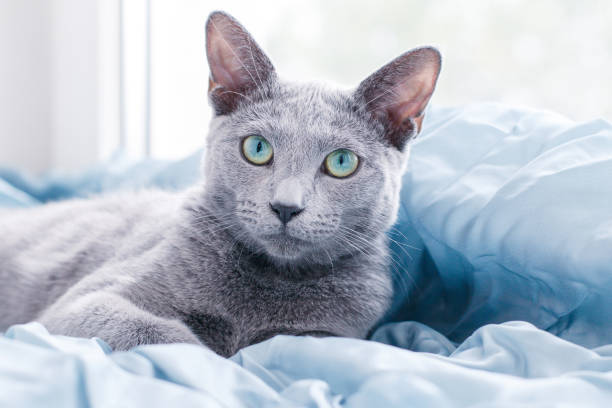Last Updated on March 8, 2024 by Fumipets
Your cat is unique — he’s yours, right? — but just because he has a grey coat doesn’t imply he’s a Russian blue. Although the large gene pool of domestic shorthairs may produce comparable characteristics, identical lookalikes are uncommon. It doesn’t take James Bond to figure out whether your cat was sent to you with affection from Russia.

Blue Genes
It’s difficult to tell if the grey cat on your lap is a genuine Russian blue or a domestic shorthair unless you have breed papers.
Nearly all Russian blues have the same characteristics: a short, thick coat; uniform grey fur with silvery tips, which breeders and fans refer to as “blue”; and green eyes. If your cat doesn’t quite fit this description, he’s most likely a domestic short-haired cat. The eyes or the coat are sometimes the sole things that distinguish them.
Purebred cats have a significantly smaller gene pool than domestic shorthairs. While they do sometimes capture some riches, the Russian blue motherlode is very uncommon.
![7+ Facts About Russian Blue Cats [Personality, History, Health & More]](https://3f0pln1qw18vn6ofv20i37p7-wpengine.netdna-ssl.com/wp-content/uploads/russian-blue-cats.jpg)
Colour-Coordinated Blue Genes
Cat genetics is very complicated, and it won’t help you tell the difference between a Russian blue and a domestic shorthair lookalike in the end. Even yet, a quick top-down glance reveals the plethora of factors that must align for an identical doppelganger.
Short hair is dominant, single-colour coats are recessive, base black hair is recessive, deeper black tint is dominant, diluted dark black tint (the grey/blue hue) is recessive, and green eyes are associated with coat colour.
Green eyes and a delicate undercoat of white hair are two of the more uncommon Russian blue characteristics.

Beyond The Physical
If your mystery cat is physically identical to the physical description but you can’t establish he’s a Russian blue, it’s time to think about personality.
Russian blue cats have a comparable disposition to domestic cats since their gene pool is smaller. They’re sociable with family members but may be very independent, timid towards strangers, quiet and trainable, but won’t use a filthy litter box.
Does it describe your cat? Keep in mind that the verdict on the nature vs. nurture argument is yet out. Some Russian Blues don’t behave the way they’re intended to, either.

The Litmus Test
Checking their kittens is the only method to identify the difference between a Russian blue and a domestic shorthair lookalike.
Your cat should (re)produce Russian blue pups if matched with a verified Russian blue partner. Mixed breeds are created when a domestic short-haired cat and a Russian blue cat are crossed, resulting in another domestic shorthair with a variety of coat colours.
This is obviously not an option if your grey cat is spayed or neutered. Were you planning to treat your cat any differently in the first place?
https://www.youtube.com/watch?v=DDickpVnbgs


















